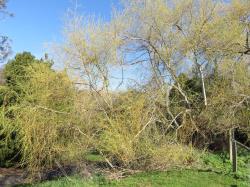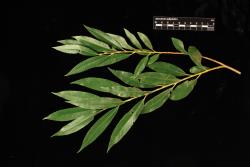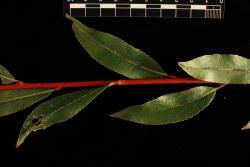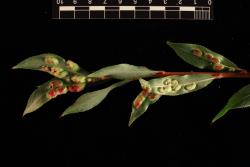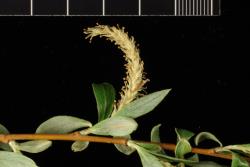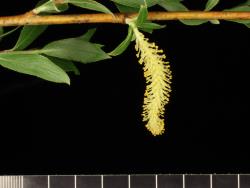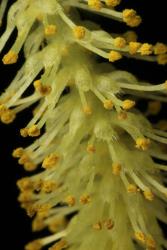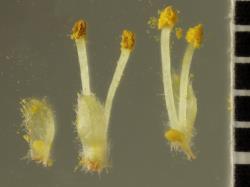- ≡ Salix vitellina L., Sp. Pl. 1016 (1753)
- ≡ Salix alba var. vitellina (L.) Stokes, Bot. Mat. Med. 4, 506 (1812)
- = Salix basfordiana Scaling ex J.Salter, Gard. Chron, n.s. 17: 298 (1882) – as Basfordiana
- = Salix vitellina var. britzensis Späth, Baumschule 1883–1884, 3 (1883) – as [infrasp. unranked] Britzensis (Späth) Blutrothe Goldweide
Erect or inclined trees to 24 m tall, a single trunk to 2.3 m diameter or with multiple trunks up to 1.4 m diameter. Current year's branchlets moderately densely short- to long-silky hairy. Year-old branchlets strong orange-yellow (UCL68) to dark reddish orange (UCL38). Flowering branch bud scales 4.0–8.0 mm long, 2.5–4.0 mm wide, strong brown to brownish orange. Stipule 0.2–1.5 mm long, gland-like to subulate. Petiole 6–20 mm long, glabrous on outer side, densely short-silky hairy on adaxial surface. Emerging leaves pale green to green. Leaf lamina 61–100 mm long, 17–19 mm wide, length to width ratio 3.7–5.3:1, narrowly elliptical to narrowly obovate, not falcate; apex acute to narrowly acute; leaf galls uncommon; upper leaf surface with sparse long-silky hairs, lower leaf surface with sparse to moderate dense long-silky hairs. Catkins female, rarely male. Male catkin 30–36 mm long, 8–10 mm diameter. Male flower bract 2.6–2.8 mm long, 0.9–1.6 mm wide. Female flowering branch not extending after flowering, with 4–5 leaves + 1 cataphyll. Female catkin 40–110 mm long. Ovary 2.3–2.6 mm long, not usually ripening into capsules (i.e. not usually swelling at the base after flowering), stipe not extending after flowering.
Forma vitellina is recognisable by its vivid golden-yellow branchlets and the lack of a weeping form (in contrast to the golden weeping willow, Salix ×pendulina f. salamonii). One-year old branchlets arch outwards and droop to some degree but are not vertically pendulous. Old trees sometimes collapse and new, multi-stemmed individuals with inclined trunks grow from the base, the new trunks eventually reaching 1.0–1.5 m diameter. The shape of the tree canopy is a flattened hemisphere as in f. fragilis. Included in f. vitellina are plants that have orange to orange-red year-old branchlets. Forma vitellina is almost exclusively female in New Zealand, while f. fragilis is mainly male. While f. fragilis nearly always has leaf galls, leaf galls have been seen on only one of many specimens of f. vitellina. Catkins of f. vitellina are exceptionally long (at flowering 40–100 mm long). They can be longer than for any other species or hybrid in subgenus Salix. Ovaries of f. vitellina usually do not enlarge by widening at the ovary base after flowering, in contrast to all other tree willow species and hybrids that have female plants in New Zealand. In cases where the ovary swells normally after flowering, branchlet colour is the only difference between f. vitellina and f. fragilis.
Most similar to Salix ×fragilis f. fragilis but differs mainly in the colour of the one-year-old branchlets, dark yellow to orange-yellow to blood-red rather than olive. Branchlets of dried specimens become red-brown and cannot be distinguished using this difference if the fresh colour was not noted at time of collection. Forma vitellina has longer flower bracts (3.0–4.0 mm long) than the S. ×pendulina hybrids, but flower bracts of female f. fragilis and female S. alba catkins also attain these lengths. Salix ×fragilis f. fragilis is mostly male in New Zealand while f. vitellina plants are mostly female. Salix alba has an equal mix of male and female plants present in New Zealand. Meikle (1984) also pointed out that the flower bract is equal in length or exceeds the ovary and style in f. vitellina and imparts to the catkin a lean and ragged appearance, but this lean, ragged look is also seen in female catkins of f. fragilis.
Marlborough (Blenheim 1975), Canterbury (Christchurch 1965, 1988, Waihora 1964, Courtenay 1964, Homebush 1964, Waitaki River 1966), Otago (Ranfurly 1966, Allanton 1966). In Canterbury and Otago f. vitellina is commonly seen on roadsides, conspicuous in winter for its erect, golden branchlets, but it can be difficult to tell in these situations if plants are wild or planted.
Common in cultivation.
First collection: CHR 143783, A.J. Healy 63/283, 22 October 1963, Waikari R., Canterbury, "river bed". One of a number of specimens collected from the Waikari riverbed on this date; it is uncertain whether these were wild or planted.
First publication: Grant & Fenton (1948).
Flowering: Late September–late October.
Tetraploid, 2n = 76 (CCDB based on 2 counts).
Belyaeva et al. (2018) considered the lectotype of Salix vitellina was not a variant of S. alba, and had also characteristics of S. euxina, and so is a hybrid of S. alba and S. euxina. Marchenko (2019) proposed S. vitellina as a forma of S. ×pendulina, but his combination is invalid because he did not cite the basionym.



